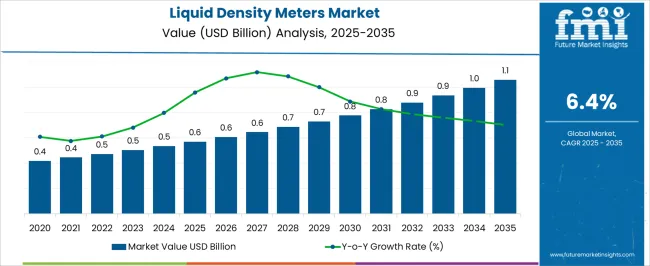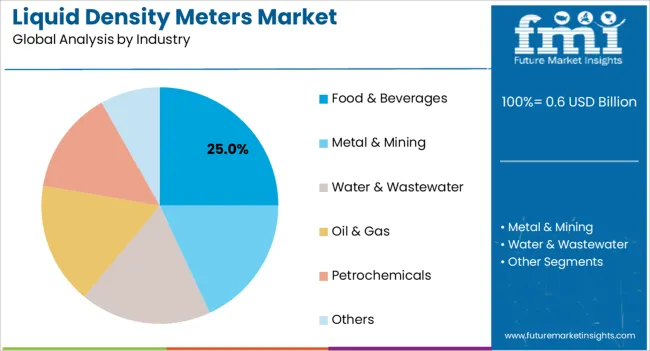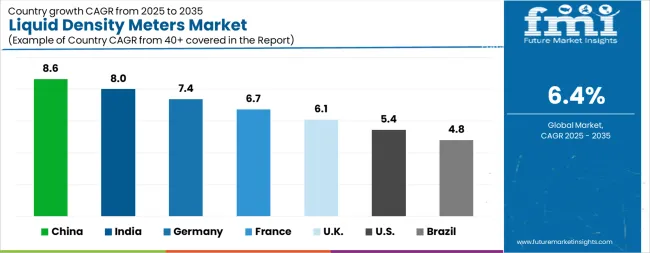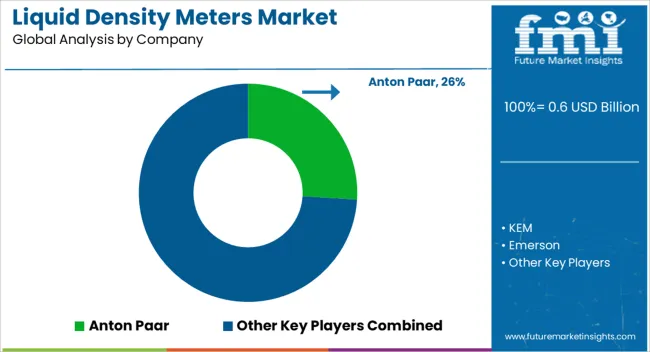The Liquid Density Meters Market is estimated to be valued at USD 0.6 billion in 2025 and is projected to reach USD 1.1 billion by 2035, registering a compound annual growth rate (CAGR) of 6.4% over the forecast period.

| Metric | Value |
|---|---|
| Liquid Density Meters Market Estimated Value in (2025 E) | USD 0.6 billion |
| Liquid Density Meters Market Forecast Value in (2035 F) | USD 1.1 billion |
| Forecast CAGR (2025 to 2035) | 6.4% |
The Liquid Density Meters market is experiencing steady growth driven by the increasing demand for precise measurement and monitoring of liquid properties across multiple industries. The current market scenario reflects growing adoption of advanced metrology instruments to ensure process optimization, quality control, and regulatory compliance. In 2025, the market is benefiting from technological innovations that enhance measurement accuracy, speed, and integration with automated control systems.
Rising investment in industrial automation, digitalization of manufacturing processes, and the need for real-time process monitoring are shaping the market’s future outlook. The deployment of liquid density meters in critical applications is being favored due to their ability to reduce material wastage, improve product consistency, and support energy-efficient operations.
Future opportunities are expected in industries requiring high precision measurements, as well as in sectors that are increasingly adopting inline monitoring solutions As industrial processes continue to evolve toward data-driven operations, liquid density meters are anticipated to remain an essential component for quality assurance and process efficiency, offering scalable solutions for both large and small-scale operations.
The liquid density meters market is segmented by product type, industry, and geographic regions. By product type, liquid density meters market is divided into In Line Liquid Density Meters and Desktop Liquid Density Meters. In terms of industry, liquid density meters market is classified into Food & Beverages, Metal & Mining, Water & Wastewater, Oil & Gas, Petrochemicals, and Others. Regionally, the liquid density meters industry is classified into North America, Latin America, Western Europe, Eastern Europe, Balkan & Baltic Countries, Russia & Belarus, Central Asia, East Asia, South Asia & Pacific, and the Middle East & Africa.

The In Line Liquid Density Meters product type is projected to hold 55.00% of the market revenue in 2025, making it the leading product segment. This dominance is being driven by its capability to perform continuous, real-time measurements directly within the production process without interrupting the workflow. The segment’s growth has been reinforced by industries seeking to reduce downtime and improve operational efficiency through inline monitoring.
The precision offered by these meters allows for better control over product formulations and minimizes quality deviations. Their adaptability to integrate with existing automated systems has further strengthened their adoption.
In environments where rapid and accurate data collection is critical, in line liquid density meters provide significant operational advantages Future growth is expected to be fueled by increasing industrial automation, demand for energy-efficient processing, and the need for high accuracy in chemical and liquid measurement processes, making this segment a key driver of overall market expansion.

The Food and Beverages industry is expected to hold 25.00% of the Liquid Density Meters market revenue in 2025, establishing it as the leading end-use industry. This prominence is being attributed to the need for precise monitoring of liquid ingredients, formulations, and mixtures to ensure product consistency, taste, and quality compliance.
The growth of this segment has been driven by rising consumer expectations for high-quality and safe food products, coupled with stricter regulatory standards on manufacturing processes. Inline density measurements are being preferred as they allow continuous monitoring without interrupting production, reducing waste and improving efficiency.
The adoption of advanced liquid density meters is also being supported by the trend toward automation and real-time process analytics in modern food and beverage plants As manufacturers increasingly seek to optimize production processes, maintain quality standards, and comply with regulatory requirements, the Food and Beverages industry is expected to remain a key growth driver for the liquid density meters market.
The rapid industrialization along with the technological advancements in water treatment technology is playing an important role in the growth of liquid density meters. The high growth and innovations in water and wastewater industries is creating the requirement for laboratory devices which are simpler to maintain and operate and due to this the demand for ultrasonic liquid density meters is increasing promptly.
Moreover, the growing demand for rugged and corrosion-resistant liquid density meters for aggressive liquid measurement is creating potential growth opportunities for liquid density meters market.
The increasing usage of liquid density meters in food & beverages, chemical, and pharmaceutical industry is supporting the growing demand for liquid density meters. In addition to this, the growing demand for liquid density meters to accelerate the production time in process industries is one of the major factors which is propelling the growth of liquid density meters market.
Furthermore, the advancements in various sectors such as diagnostics and forensics research is creating the potential growth opportunities for liquid density meters market.

| Country | CAGR |
|---|---|
| China | 8.6% |
| India | 8.0% |
| Germany | 7.4% |
| France | 6.7% |
| UK | 6.1% |
| USA | 5.4% |
| Brazil | 4.8% |
The Liquid Density Meters Market is expected to register a CAGR of 6.4% during the forecast period, exhibiting varied country level momentum. China leads with the highest CAGR of 8.6%, followed by India at 8.0%. Developed markets such as Germany, France, and the UK continue to expand steadily, while the USA is likely to grow at consistent rates. Brazil posts the lowest CAGR at 4.8%, yet still underscores a broadly positive trajectory for the global Liquid Density Meters Market. In 2024, Germany held a dominant revenue in the Western Europe market and is expected to grow with a CAGR of 7.4%. The USA Liquid Density Meters Market is estimated to be valued at USD 200.0 million in 2025 and is anticipated to reach a valuation of USD 339.7 million by 2035. Sales are projected to rise at a CAGR of 5.4% over the forecast period between 2025 and 2035. While Japan and South Korea markets are estimated to be valued at USD 28.5 million and USD 16.1 million respectively in 2025.

| Item | Value |
|---|---|
| Quantitative Units | USD 0.6 Billion |
| Product Type | In Line Liquid Density Meters and Desktop Liquid Density Meters |
| Industry | Food & Beverages, Metal & Mining, Water & Wastewater, Oil & Gas, Petrochemicals, and Others |
| Regions Covered | North America, Europe, Asia-Pacific, Latin America, Middle East & Africa |
| Country Covered | United States, Canada, Germany, France, United Kingdom, China, Japan, India, Brazil, South Africa |
| Key Companies Profiled | Anton Paar, KEM, Emerson, Mettler Toledo, Thermo Scientific, Alfa Mirage, Kruess, Bopp & Reuther, ISSYS, and Rudolph |
The global liquid density meters market is estimated to be valued at USD 0.6 billion in 2025.
The market size for the liquid density meters market is projected to reach USD 1.1 billion by 2035.
The liquid density meters market is expected to grow at a 6.4% CAGR between 2025 and 2035.
The key product types in liquid density meters market are in line liquid density meters and desktop liquid density meters.
In terms of industry, food & beverages segment to command 25.0% share in the liquid density meters market in 2025.






Our Research Products

The "Full Research Suite" delivers actionable market intel, deep dives on markets or technologies, so clients act faster, cut risk, and unlock growth.

The Leaderboard benchmarks and ranks top vendors, classifying them as Established Leaders, Leading Challengers, or Disruptors & Challengers.

Locates where complements amplify value and substitutes erode it, forecasting net impact by horizon

We deliver granular, decision-grade intel: market sizing, 5-year forecasts, pricing, adoption, usage, revenue, and operational KPIs—plus competitor tracking, regulation, and value chains—across 60 countries broadly.

Spot the shifts before they hit your P&L. We track inflection points, adoption curves, pricing moves, and ecosystem plays to show where demand is heading, why it is changing, and what to do next across high-growth markets and disruptive tech

Real-time reads of user behavior. We track shifting priorities, perceptions of today’s and next-gen services, and provider experience, then pace how fast tech moves from trial to adoption, blending buyer, consumer, and channel inputs with social signals (#WhySwitch, #UX).

Partner with our analyst team to build a custom report designed around your business priorities. From analysing market trends to assessing competitors or crafting bespoke datasets, we tailor insights to your needs.
Supplier Intelligence
Discovery & Profiling
Capacity & Footprint
Performance & Risk
Compliance & Governance
Commercial Readiness
Who Supplies Whom
Scorecards & Shortlists
Playbooks & Docs
Category Intelligence
Definition & Scope
Demand & Use Cases
Cost Drivers
Market Structure
Supply Chain Map
Trade & Policy
Operating Norms
Deliverables
Buyer Intelligence
Account Basics
Spend & Scope
Procurement Model
Vendor Requirements
Terms & Policies
Entry Strategy
Pain Points & Triggers
Outputs
Pricing Analysis
Benchmarks
Trends
Should-Cost
Indexation
Landed Cost
Commercial Terms
Deliverables
Brand Analysis
Positioning & Value Prop
Share & Presence
Customer Evidence
Go-to-Market
Digital & Reputation
Compliance & Trust
KPIs & Gaps
Outputs
Full Research Suite comprises of:
Market outlook & trends analysis
Interviews & case studies
Strategic recommendations
Vendor profiles & capabilities analysis
5-year forecasts
8 regions and 60+ country-level data splits
Market segment data splits
12 months of continuous data updates
DELIVERED AS:
PDF EXCEL ONLINE
Liquid Processing Filter Market Size and Share Forecast Outlook 2025 to 2035
Liquid Mandrel Release Agent Market Size and Share Forecast Outlook 2025 to 2035
Liquid Filling Machine Market Size and Share Forecast Outlook 2025 to 2035
Liquid Oxygen Generator Market Size and Share Forecast Outlook 2025 to 2035
Liquid Packaging Bag Market Size and Share Forecast Outlook 2025 to 2035
Liquid Carton Packaging Market Size and Share Forecast Outlook 2025 to 2035
Liquid Desiccant Natural Gas Dehydration Unit Market Size and Share Forecast Outlook 2025 to 2035
Liquid Filled Pressure Gauges Market Size and Share Forecast Outlook 2025 to 2035
Liquid Filtration Market Size and Share Forecast Outlook 2025 to 2035
Liquid Packaging Board Market Size and Share Forecast Outlook 2025 to 2035
Liquid Filled Capsule Market Size and Share Forecast Outlook 2025 to 2035
Liquid Cold Plates Market Size and Share Forecast Outlook 2025 to 2035
Liquid Crystal Polymers Market Size and Share Forecast Outlook 2025 to 2035
Liquid Embolic Agent Market Size and Share Forecast Outlook 2025 to 2035
Liquid Hydrogen Market Size and Share Forecast Outlook 2025 to 2035
Liquid Cooled Home Standby Gensets Market Size and Share Forecast Outlook 2025 to 2035
Liquid Nitrogen Purge Systems Market Size and Share Forecast Outlook 2025 to 2035
Liquid Chromatography Systems Market Size and Share Forecast Outlook 2025 to 2035
Liquid Armor Materials Market Size and Share Forecast Outlook 2025 to 2035
Liquid Synthetic Rubber Market Size and Share Forecast Outlook 2025 to 2035

Thank you!
You will receive an email from our Business Development Manager. Please be sure to check your SPAM/JUNK folder too.
Chat With
MaRIA